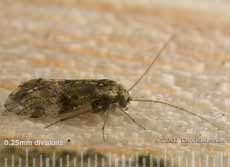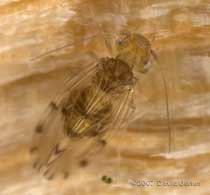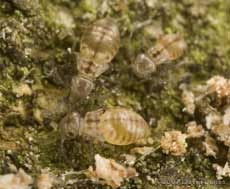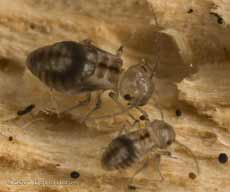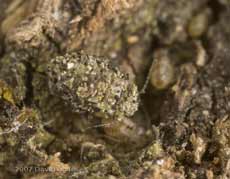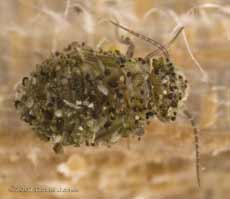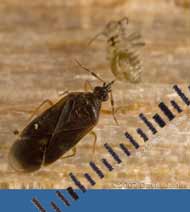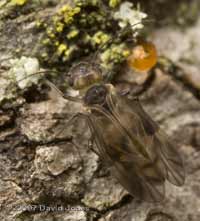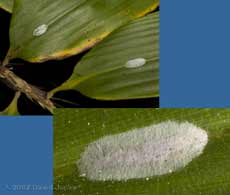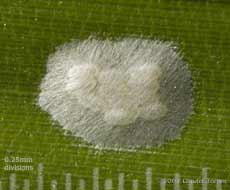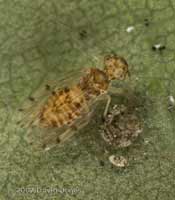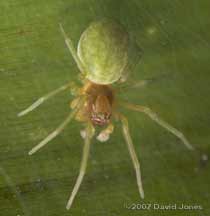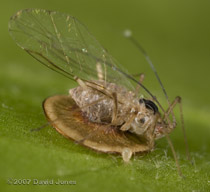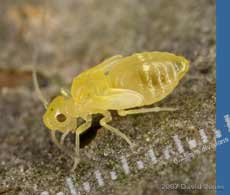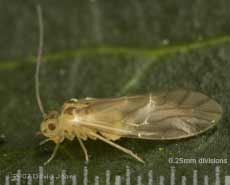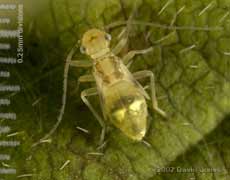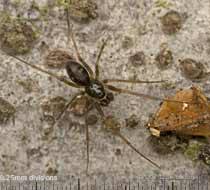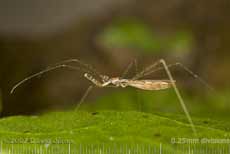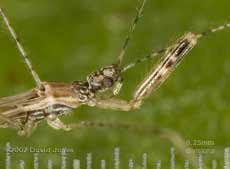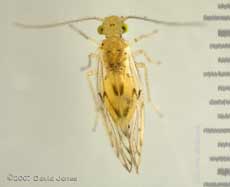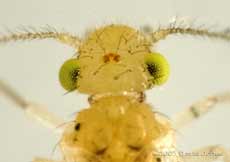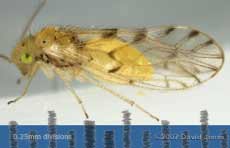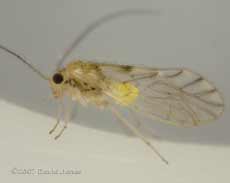Go to the last entry on this page ... ....Go to previous entry4 October - A Dull and damp start to the month that had us lighting our log burner has given way to sunshine, and today it has been very pleasant. During the day I decided to bring an armful of logs into the house from the West Wing, not to use today, but to dry out ready for the next cold morning. It was obvious that I was not only bringing wood into the house but also small populations of tiny inhabitants, mainly barkflies - instead of taking my camera out into the garden I simply had to point it towards the logs! The largest barkflies, of which I saw three, was this species with a largely green-yellow head very spotty wings. Bob Saville (National Barkfly Recording Scheme organiser) has identified this species as Loensia variegata, a barkfly that is uncommon in the UK.
The only other wings barkfly that I found on the logs was this much smaller example which was far less obvious on the cut surfaces of the wood. This, and the nymphs in the next photograph are examples of Ectopsocus petersi, a barkfly that I find all over the garden.
Much more numerous were wingless examples which I suspect are nymphs. The most numerous look like these,
although some on one log were darker in colour.
While both the previous examples were quite easy to see, despite the largest being no more than a couple of millimetres long, a third type was much more difficult to see. In this photograph it is easier to make out the (out-of-focus) nymphs in the background than the nymph in the foreground. Bob suspects that these could be the nymphs of Loensia variegata.
It is only when one moves onto a cut surface that you really get the chance to see that it is actually a barkfly nymph. Unlike the previous examples, this one camouflages itself with debris, including what appear to be its own droppings. When one of these barkflies is stationary on the bark the camouflage is almost perfect until it decides to move.
The barkflies almost seemed to have the logs to themselves. However, while other (visible) species were apparently absent from the logs that I examined, I did find two similar looking bugs, one of which was tucking into a meal!
Away from the logs, I found an adult Harlequin Ladybird on a bamboo plant on the West Wing. At least it was out-numbered by the six Orange Ladybird adults That I have seen on the Birch tonight. They were all quite pale, looking as though they have only just emerged today. The hedgehogs are still active. I put out food for them and that is usually visited by 8pm now that the evenings are dark. It won't belong before the nights are cold enough to encourage them to stay 'indoors'. I'm not seeing any tiny individuals coming for food so hopefully, after the success this year the hedgehog house will be used for hibernation this winter.
5 October - The spell of good weather continued today with blue skies over us for most of the time. I have been grateful once again to Bob Saville, the National Barkfly Recording Scheme organiser for assisting with identifications. If you wish to find out more about these largely overlooked insects, it is worth visiting the National Barkfly Recording Scheme website that he has set up.
This one measured around 4mm in length and I found five individuals on one log. Thanks to Bob, it has been identified as Peripsocus milleri, a species regarded as scarce in England and not previously reported from this part of the country. It looks as though in future I shall have to check the logs before taking them away for our burner! The only other winged example that I found amongst the timber was a single specimen of Loensia variegata.
Next, I turned my attention to the bamboo plants where yesterday I had noticed numerous egg clusters on the upper surfaces of leaves. All the groups are covered with dense, matted layer of silk threads, making it difficult to see the individual eggs with their iridescent casings. Some, like the ones shown here, are elongated and positioned above the central vein of the leaf. The longest one measures about 4mm in length.
Other egg clusters are more rounded and positioned rather more randomly on the upper leaf surfaces. In these clumps the eggs are easier to make out. While I believe that the eggs have been laid by barkflies, I could see no sign of adults on the leaves photographed here.
In contrast to that situation, a look under an Oak leaf revealed another group of eggs, this time easily seen and obviously being watched over by an adult (I assume the parent) Ectopsocus petersi.
There are lots of large, healthy looking Common Garden Spiders about now, often building their large webs across the path and catching me out as I walk down the garden, but I have yet to photograph them this Autumn. However, I did point my camera at a much smaller spider that caught my eye as it rested on the top of another bamboo leaf. This individual measures just over 3mm in length. I'm grateful to Jürgen Peters from Borgholzhausen in Germany for providing me with the identity of this species (Click on his name to see his websit4 in a new window). Jürgen tells me that it is a female Nigma walckenaeri (Dictynidae). It isn't illustrated in my spider field guide, but the book notes that in the UK it is only recorded in the South-east of England where it has a very local distribution.
Finally, an aphid, although this one has fallen victim to a parasitic attack on an Ivy leaf. I need to remind myself whether this was caused by a fungus or a parasitic Braconid wasp, although in examples that I've recorded of the latter the structure formed below the aphid has been rather more conical than disc shaped. Notice the mites that turn up to feed on the remains.
6 October - Another nice day, if a bit more cloudy than yesterday.
Another Barkfly nymph for the records, this time under a log on top of a small log pile in the open under the Ivy tree. In a dramatic contrast to the camouflaged nymph of two days ago, this individual (and just one other on the same log) stood out from the wood as if wearing a high-visibility jacket.
7 October - The fine weather continues - a brighter day with sunny spells after an overcast start. A couple more barkfly photographs as I continue to check how many species I can find in the garden this Autumn.
The first was actually photographed yesterday on Elder - I believe that it is a Valenzuela flavidus, a common species here in the UK. This species is largely yellow in colour, making me wonder if the yellow nymph pictured above is of this species.
The second is this nymph, found today on our Berberis plant, although I photographed it on a different leaf as it constructed a new silk protective shelter for itself. The two yellow patches on its abdomen show up very clearly against the green background. At some point I must set up a small container so that I can follow the progress of nymphs like this one so that I can link them with the adults that I find.
Now two small predators - First a small spider from the log pile, another male (photographed yesterday). I suspect that it belongs to the family Linyphiidae, but beyond that I can't progress.
The second predator is a much more delicate, and stealthy hunter found in the Berberis bush, and the nearest we get to a Praying Mantis in our garden! It is an assassin bug, possibly Empicoris vagabunus. While it is quite capable of flight, it moves over the leaves very slowly using its four hind legs.
The front pair of modified (raptorial) legs are used to seize its prey (small athropods). Once captured, the victim is stabbed using the bug's stout beak (or rostrum) which you can see tucked under its head and between the front legs in this cropped image.
There are still Carder Bees visiting the garden, going to both the Cosmos flowers, and the Fuchsia plant at the front of the house, although both plants show signs of coming to the end of their blossoming periods now. Around 10pm last night there were three hedgehogs (two large and one smaller, although it must have been at least 500gm in weight) gathered around the food, which is great to see. By this morning the stepping stone was clear of food.
8 October - a dull, grey day, dry but with a high no more than 15C. Thanks to Bob Saville (see above) I now know the identity of the adult barkfly that I photographed on the 5th, and it turns out to be scarce in England and the first time the species has been reported from this part of the country. I have amended that diary entry with the details. Today, the hunt continued, at least for a short while, and this is a barkfly that I found when I shook part of the Pyracantha that grows next to the veranda. It was too active to photograph in situ so I had to take it into temporary captivity to get any pictures, which is why it is photographed against a plain background.
9 October - A thoroughly wet morning, with the rain giving way to sunshine in the late afternoon -tonight the sky is cloudless.
Yesterday's barkfly is still waiting for a name, although it is now down to a choice between two species. This morning I spent some time trying to get a clearer picture of the wings (especially a hind wing) to help clarify the ID.
Since taking that photograph I have dissected the barkfly so that I could take a photograph of the hind wing on its own. This is not something that I normally do, but with the prospect of being able to record another scarce species in the garden I decided to make an exception on this occasion. It looks as though it is Trichopsocus clarus, as suspected by Bob. You can see the results, and more information by clicking on the image above.
However, in addition to not having green eyes, this individual seems to be lacking most of the dark wing patches, and the abdomen is very much reduced. Despite these differences, Bob thinks that it is probably also T. clarus, showing just how careful you have to be with the identification process - they don't always have green eyes, and their markings can be very feint! Trichopsocus clarus would be the second nationally scarce barkfly species to be recorded in the garden during this last week. I wonder how many more are waiting to be found, and to what extent 'scarce' could be read as 'grossly under-reported'?
10 October - A dry but overcast day. I haven't done anything in the garden today, but I have spent some time taking photographs of barkfly wings - an interesting challenge when the slightest draught would carry the wings away!). See yesterday's entry which has been amended.
It is interesting to compare its wings with those of T.clarus. Click on the image to see both sets.
Click on images to see larger versions |
|
